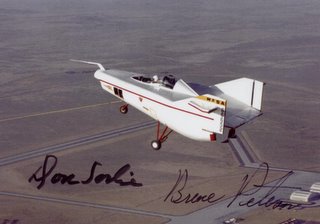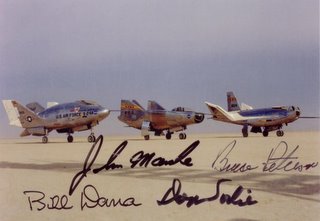Lifting Bodies Multi-Signed
 X-24B
X-24BThe X-24A was later modified into the X-24B. The bulbous shape of the X-24A was converted into a "flying flatiron" shape with a rounded top, flat bottom, and double delta platform that ended in a pointed nose. The X-24B demonstrated that accurate unpowered reentry vehicle landings were operationally feasible. Top speed achieved by the X-24B was 1,164 mph and the highest altitude it reached was 74,130 feet. The vehicle is on display at the Air Force Museum, Wright-Patterson Air Force Base, Ohio. The pilot on the last powered flight of the X-24B was Bill Dana, who also flew the last X-15 flight about seven years earlier.
Top speed reached with the X-24B was 1,164 mph (Mach 1.75) by Love on October 25, 1974. The highest altitude reached was 74,100 feet, by Manke on May 22, 1975.
The X-24B is on public display at the Air Force Museum, Wright-Patterson AFB, Ohio.
 M2-F1
M2-F1The prototype of a 21st Century spacecraft required the fabrication of hundreds of small wooden parts meticulously nailed and glued together. It was a product of craftsmanship that was nearly obsolete in the 1940s.
On April 5, 1963 Milt Thompson lifted the M2-F1's nose off of the ground for the first time on-tow. Speed was 86 miles per hour. The little craft seemed to bounce uncontrollably back and forth on the main landing gear, and stopped when he lowered the nose to the ground. He tried again, but each time with the same results. He felt it was a landing gear problem that could have caused the aircraft to roll on its back if he had lifting the main gear off of the ground.
More than 400 ground tows and over 100 aircraft tow flights were carried out with the M2-F1. The success of Dryden's M2-F1 program led to NASA's development and construction of two heavyweight lifting bodies based on studies at NASA's Ames and Langley research centers -- the M2-F2 and the HL-10, both built by the Northrop Corporation, and the X-24 program. The Lifting Body program also heavily influenced the Space Shuttle program.

M2-F2
The success of Dryden's M2-F1 program led to NASA's development and construction of two heavyweight lifting bodies based on studies at NASA's Ames and Langley research centers -- the M2-F2 and the HL-10, both built by the Northrop Corporation. The "M" refers to "manned" and "F" refers to "flight" version. "HL" comes from "horizontal landing" and 10 is for the tenth lifting body model to be investigated by Langley.
The first flight of the M2-F2 -- which looked much like the "F1" -- was on July 12, 1966. Milt Thompson was the pilot. By then, the same B-52 used to air launch the famed X-15 rocket research aircraft was modified to also carry the lifting bodies. Thompson was dropped from the B-52's wing pylon mount at an altitude of 45,000 feet on that maiden glide flight.
The M2-F2 weighed 4,620 pounds, was 22 feet long, and had a width of about 10 feet.
On May 10, 1967, during the sixteenth glide flight leading up to powered flight, a landing accident severely damaged the vehicle and seriously injured the NASA pilot, Bruce Peterson.
M2-F3
NASA pilots and researchers realized the M2-F2 had lateral control problems, even though it had a stability augmentation control system. When the M2-F2 was rebuilt at Dryden and redesignated the M2-F3, it was modified with an additional third vertical fin -- centered between the tip fins -- to improve control characteristics.
The M2-F2/F3 was the first of the heavy-weight, entry-configuration lifting bodies. Its successful development as a research test vehicle answered many of the generic questions about these vehicles.
NASA donated the M2-F3 vehicle to the Smithsonian Institute in December 1973. It is currently hanging in the Air and Space Museum along with the X-15 aircraft number 1, which was its hangar partner at Dryden from 1965 to 1969.
HL-10
First flight of the HL-10 was on Dec. 22, 1966. The first 11 drop flights from the B-52 launch aircraft were powerless glide flights to assess handling qualities, stability, and control.
The HL-10 (tail #804) was flown 37 times during the Lifting Body Research Program and logged the highest altitude and fastest speed in the program. First flight was Dec. 22 1966. On Feb. 18, 1970, Air Force test pilot Peter Hoag piloted the HL-10 to Mach 1.86 (1,228 mph). Nine days later, NASA pilot Bill Dana flew the vehicle to 90,030 feet, which became the highest altitude reached in the program.
The HL-10 helped develop energy management and landing techniques used presently with the space shuttle orbiters.
X-24A
Built by Martin Aircraft Company, Maryland, for the U.S. Air Force, the X-24A was a bulbous vehicle shaped like a teardrop with three vertical fins at the rear for directional control. It weighed 6,270 pounds, was 24.5 feet long and 11.5 feet wide (measuring just the fuselage, not the distance between the tips of the outboard fins). Its first unpowered glide flight was on April 17, 1969, with Air Force Maj. Jerauld Gentry at the controls. Gentry also piloted its first powered flight on March 19, 1970.
The X-24A was flown 28 times in the program that, like the HL-10, validated the concept that a Space Shuttle vehicle could be landed unpowered. The fastest speed achieved by the X-24A was 1,036 miles per hour (mph--Mach 1.6). Its maximum altitude was 71,400 feet. It was powered by an XLR-11 rocket engine with a maximum theoretical vacuum thrust of 8,480 pounds.


<< Home